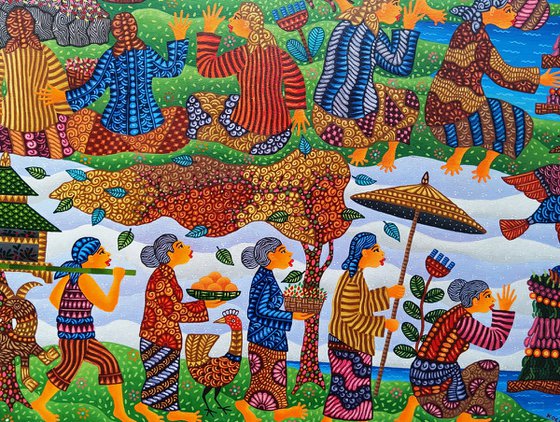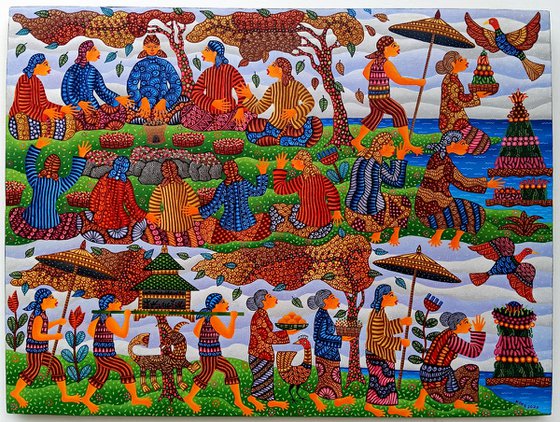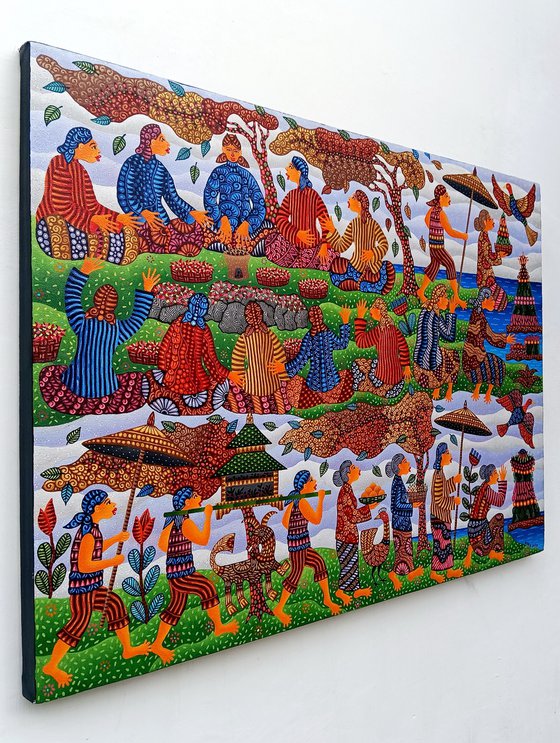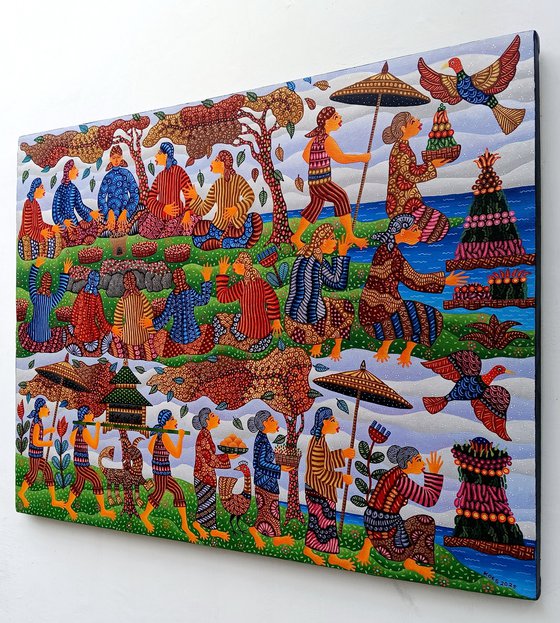Main Navigation
Original artwork description:
In a small village surrounded by green rice fields and bamboo groves, the people still preserve an ancient tradition: presenting offerings to their ancestors. This tradition is not merely about placing flowers, food, or incense in a sacred place, but also a way of showing respect, gratitude, and remembrance that today’s life is inseparable from the deeds of those who came before.
Every year, before the harvest season, the villagers gather at the communal hall or the ancestral house. The elders lead the ceremony, while the women prepare offerings such as cone-shaped rice (tumpeng), fruits, seven kinds of flowers, and water in a clay jar. Incense is lit, its smoke curling slowly upward, carrying prayers believed to reach the realm of the ancestors.
Children sit quietly beside their parents, listening to old tales about great-grandfathers who built the village, about the ancestors who first opened the rice fields, or about the village warriors who fell defending the land. In that moment, the offerings are not only symbols of devotion but also a bridge connecting the present with the past.
For them, giving offerings is not an act of worshiping the ancestors, but honoring their footsteps. The offerings are a language of gratitude: gratitude for the harvest, gratitude for health, gratitude for the continuity of life. After the prayers are spoken, the offerings are shared and eaten together, symbolizing that the blessings of the ancestors are passed on to the next generation.
This tradition keeps the villagers close to their roots. They believe that as long as prayers and offerings continue, the spirits of the ancestors will guard the village, protect the fields from pests, and bring peace to the families who live there.
And in every curl of incense smoke, it feels as though a soft whisper comes from the past:
"Guard this land, preserve your kinship, and never forget where you came from."
Materials used:
acrylik on canvas
Tags:
#traditional art #full beautiful #traditional patern #traditional culture #art cultureSESAJI ( Offerings ) (2025) Acrylic painting
by Kus Budiyanto
£1,217.28
- Acrylic painting on Canvas
- One of a kind artwork
- Size: 120 x 90 x 3cm (unframed) / 120 x 100cm (actual image size)
- Ready to hang
- Signed on the front
- Style: Illustrative
- Subject: People and portraits
Loading
Original artwork description
In a small village surrounded by green rice fields and bamboo groves, the people still preserve an ancient tradition: presenting offerings to their ancestors. This tradition is not merely about placing flowers, food, or incense in a sacred place, but also a way of showing respect, gratitude, and remembrance that today’s life is inseparable from the deeds of those who came before.
Every year, before the harvest season, the villagers gather at the communal hall or the ancestral house. The elders lead the ceremony, while the women prepare offerings such as cone-shaped rice (tumpeng), fruits, seven kinds of flowers, and water in a clay jar. Incense is lit, its smoke curling slowly upward, carrying prayers believed to reach the realm of the ancestors.
Children sit quietly beside their parents, listening to old tales about great-grandfathers who built the village, about the ancestors who first opened the rice fields, or about the village warriors who fell defending the land. In that moment, the offerings are not only symbols of devotion but also a bridge connecting the present with the past.
For them, giving offerings is not an act of worshiping the ancestors, but honoring their footsteps. The offerings are a language of gratitude: gratitude for the harvest, gratitude for health, gratitude for the continuity of life. After the prayers are spoken, the offerings are shared and eaten together, symbolizing that the blessings of the ancestors are passed on to the next generation.
This tradition keeps the villagers close to their roots. They believe that as long as prayers and offerings continue, the spirits of the ancestors will guard the village, protect the fields from pests, and bring peace to the families who live there.
And in every curl of incense smoke, it feels as though a soft whisper comes from the past:
"Guard this land, preserve your kinship, and never forget where you came from."
Materials used:
acrylik on canvas
Tags:
#traditional art #full beautiful #traditional patern #traditional culture #art culture14 day money back guaranteeLearn more




